High-level summary report — Use of te reo Māori online
How can we improve the presentation of reo Māori content on our digital channels? Te reo Māori speakers interviewed told us their expectations for te reo Māori on digital channels. Report includes findings and recommended next steps.
Download the report
This is the web version of High-level summary report — Use of te reo Māori online.
You can also download the PDF version High-level summary report — Use of te reo Māori online (pdf, 2.30 KB)
He mihi
E te hunga e kaingākaunui ana ki tō tātou reo rangatira me ngā tikanga, tēnā rā koutou.
Mokori anō kia rere ngā mihi whakamānawa ki a koutou i tau ai ki tō mātou taha ki te kōrero mō ō koutou whakapapa me ō koutou haerenga ako, ki te huritao ki te mahi a ō tātou tūpuna, ki te whakaputa i ngā whakaaro hei tārai i te ara ki anamata.
Ko te tūmanako, mā ēnei kōrero e puta ai he rautaki he mahi hoki kia whakapikitia te reo, kia whakawhānuitia te reo kia noho ai te reo Māori hei reo matua mō te tini me te mano.
E kore te puna o mihi e mimiti mā koutou.
The beginning — The background of this kaupapa
To support the goal of having one million reo Māori speakers by 2040, Archives New Zealand, The National Library and Te Papa Tongarewa are continuing to deepen their commitment to increasing visibility of te reo Māori and access to taonga Māori across their websites.
As part of this commitment, Archives New Zealand, The National Library and Te Papa Tongarewa want to learn how best to approach the usage and presentation of te reo Māori across each of their digital channels (i.e. websites, social media) to create an experience that is both welcoming and mana enhancing.
Indigenous Design and Innovation Aotearoa (IDIA) has been engaged to help these institutions better understand what a great te reo Māori experience could look like, based on the expectations of reo Māori speakers with varying levels of confidence, experience and proficiency when engaging with reo Māori content.
What we wanted to better understand — Research objectives
Before we began our interviews, we co-created a number of research objectives.
Understand the significance of te reo Māori to different people.
Develop a deep understanding of what makes Māori feel welcomed and that their language and culture is valued when using our online services.
Understand the level of reo Māori that best suits different learning levels.
Understand where the inclusion of reo Māori content is most effective and impactful for those browsing our kohinga taonga.
Understand how people are developing their knowledge of te reo Māori.
Understand the quality of whakaMāoritanga expected, the voice, and the proportion of translated content in relation to the language proficiency of those using our online services.
Understand the importance and expectation of including content that acknowledges reo ā-iwi, mita, and rohe/iwi specific kupu, kīwaha and kīanga as part of the experience.
Our interviews
Who we spoke with
We facilitated 12 one-to-one interviews with reo Māori speakers with whakapapa Māori.
Māori tertiary students spanning a range of ages including rangatahi, pakeke and kaumātua at a beginner or an intermediate level of reo proficiency.
Rangatahi Māori currently enrolled in whare kura.
First Language Speakers
We prioritised the voices of tāngata Māori throughout this initiative due to the commitment to Maihi Karauna and our acknowledgement that Māori are kaitiaki of te reo.
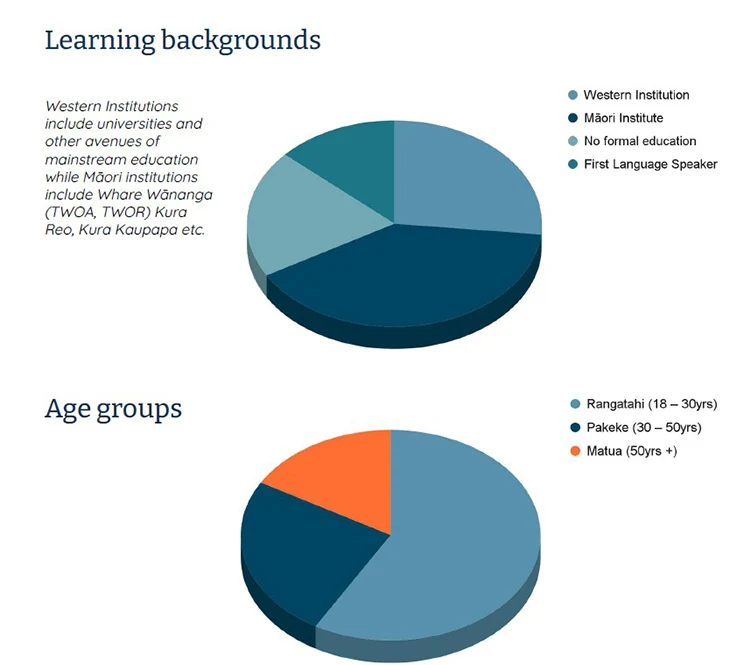
Pie charts showing information about the research participants. Supplied by IDIA, Indigenous Design and Innovation Aotearoa.
Our interview approach
We facilitated 12 one-to-one interviews with a number of tāngata Māori with various familiarity and confidence speaking te reo Māori, who had grown up with te reo in the household or on the marae, who had come through kura, or were developing their reo Māori by attending whare wānanga, night classes or kura reo.
These ran for ~45-min and took place online over video call and in-person at our office. The interviews were focused yet colloquial and were delivered in a way that was mana-enhancing in an environment that we designed to feel safe, free and supportive.
Interview focus
Understanding of people's’ relationship with te reo Māori.
Evaluating existing digital reo Māori experiences and recognising what makes for a welcoming reo Māori experience.
Desired output
A benchmark outlining the qualities of what a great reo Māori website looks like.
Note-taking and thematic analysis
Audio recordings were created to support those note-taking, and digital notes were captured, collated and refined using Notability before being anonymised and brought into Miro for thematic analysis.
These will be deleted 3 weeks after the completion of this research engagement.
Selected websites for evaluation
Te Taura Whiri i Te Reo Māori
What sets it apart:
A largely rumaki Māori experience with a language toggle enabling people to access an English language experience instead.
Āhua Māori including photography, patterns etc.
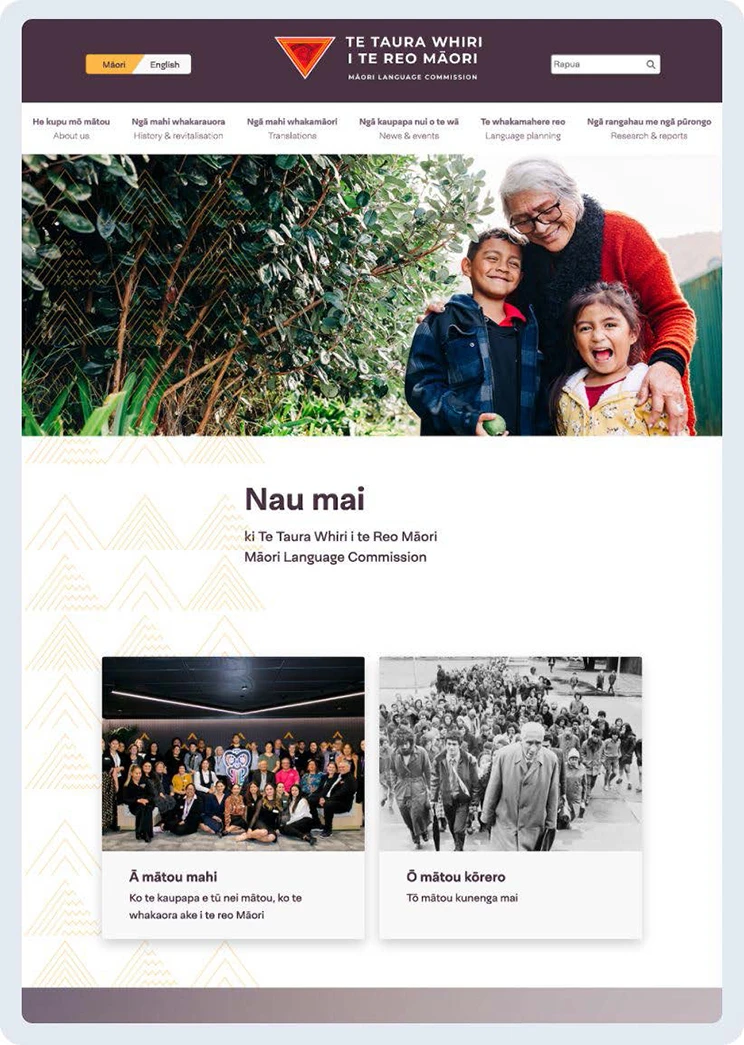
Home page of Te Taura Whiri i Te Reo Māori website.
Aotearoa Reorua
What sets it apart:
Simultaneous side-by-side dual-language display of te reo Māori and English for headings, navigation and large blocks of body copy.
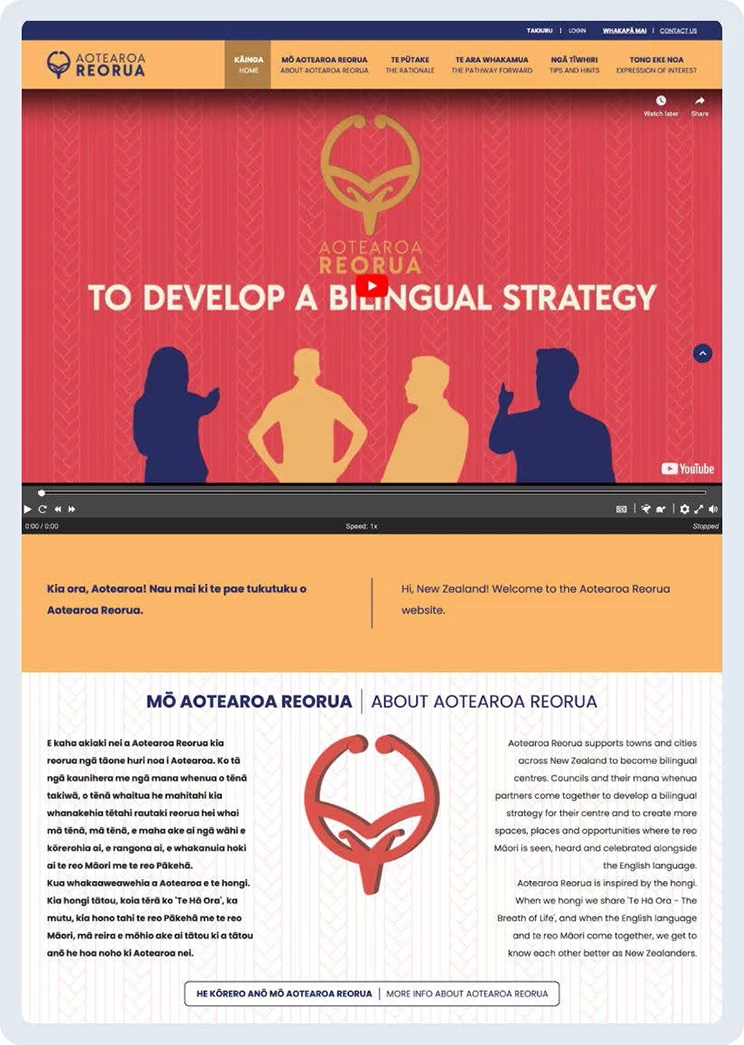
Home page of Aotearoa Reorua website.
Stuff — Pou Tiaki
What sets it apart:
Reo Māori headings
Simultaneous dual-language display of te reo Māori and English for large blocks of body copy. Eg. first paragraph is presented in te reo Māori, the following paragraph provides an English translation.

Home page Stuff website.
Waikato Tainui
What sets it apart:
Dual-language headings
Kupu Māori interspersed throughout
Āhua Māori including photography, patterns etc.

Home page of Waikato Tainui website.
Observations and findings from our interviews
Research objectives
Understand the significance of te reo Māori to different people.
Understand how people are developing their knowledge of te reo Māori.
Te reo Māori is of great significance to all speakers regardless of how matatau they are in the reo.
They are actively reaching on a number of resources, people, and spaces to further their knowledge of te reo Māori and develop their connection to their culture. Some of these include language books, social media and podcasts, ondemand TV, enrolling in formal learning environments and returning home to speak with kaumātua and whanaunga.
‘You don't know how empty you are until you've experienced what it's like to be full. For reo itself, but also to be in a reo environment.’
‘Te reo has made me the person I am today. It has shifted me from being painfully shy to — just a little bit shy.’
‘In terms of oranga, I feel like reo is the thing that gives me the most oranga — ā-hinengaro, ā-wairua, ā-putea! It's all of it.’
Research objective
Develop a deep understanding of what makes Māori feel welcomed and that their language and culture is valued when using our online services.
Despite a strong desire to actively develop their understanding of te reo Māori and confidence to kōrero, all participants recognised that there are very few spaces that invite them to be authentically Māori and that it was often up to them to seek out or create spaces to kōrero and share whakaaro Māori.
‘My place is definitely myself. I have to create that environment for myself because only I have the power.’
‘I went to this one cafe and it had this big massive sign and it was like English names of coffee and te reo Māori names. And it wasn’t like that small little print, like that tokenistic translation. And I was like “this is mean as”.’
Reo Māori speakers often rely on cues, both visual and audible, that encourage them to feel welcome to be authentically Māori and that their reo and culture was valued.
Māori desire to see themselves and their Māoritanga reflected in the experience, and feel most comfortable when there is a more obvious āhua Māori to the website consisting of reo Māori and imagery relating to or expressing aspects of te ao Māori.
‘If I visit any site, being able to see myself visually represented is important to me. So the graphics are very important to me. If it has the reo, I can feel the āhua of the site, and understand that “OK, this is a safe space for me to move into and to navigate with our Māori worldview as well”. So even if I don’t have the reo, it is still very important that this space feels welcoming to me as Māori.’
There are a number of ways to communicate the importance and value of ahurea Māori.
Indicators that this is a Māori-friendly space:
Visual cues such as bilingual signage or posters, menus etc.
Audible cues such as music or sounds of te taiao.
The types of people who are present and the types of kaupapa.
Toi Māori, whakairo or kowhaiwhai, and the presence of taonga Māori.
Being approached by people in te reo Māori can also make the space feel comfortable to kōrero Māori.
‘For example at the museum — if they have a Māori song playing, even just the instrumental — that can be encouraging to kōrero Māori.’
Photographs offer a powerful way to personalise the digital experience.
Photographs offer a powerful way to personalise the digital experience and help Māori see themselves reflected in the experience creating a space that feels safe and welcoming to tāngata Māori.
This is particularly impactful when imagery includes interactions between Māori of different generations or unique and relatable Māori interactions such as hongi. Additionally, including images of taonga Māori and toi Māori work to support the idea that the space is welcoming to Māori and encouraging of Māori to engage fully as Māori.
‘I love the imagery, I know straight away that I'm in a Māori place. (In reference to Te Taura Whiri’s website)’
Explore the use of patterns, motifs and other media
Use of relevant imagery such as photos, patterns or motifs as well as motion graphics and video are particularly crucial when developing an āhua Māori that is engaging for Māori audiences.
Māori typefaces have the potential to imbue the reo with familiar qualities from te ao Māori
Māori typefaces that have qualities reminiscent of toi Māori or whakairo Māori such as TWOA's Uhi are highly recognisable to tāngata Māori and offer another way to develop a space with an āhua Māori that is welcoming to tāngata Māori.
‘If there's Māori imagery or I can see te reo Māori, that will encourage me [to engage in Māori]. If the organisation has a Māori name, that might also be another signal.’
Te reo Māori content should be presented prominently
All participants expected that the te reo Māori content would be displayed first, either from top to bottom or left to right. They also expected that it would be visually distinguishable to clearly indicate its importance and value.
All participants expected headings and navigation items to be offered in te reo Māori. Additionally, they indicated a preference to see Māori titles displayed first, followed by their English equivalents.
‘When we privilege and normalise te reo in those spaces, we can do a lot of healing in terms of fixing the narrative that says te reo is not relevant. We can start healing racism if we gently place it in their environment, and hopefully bring others into our spaces.’
Research objectives
Understand where the inclusion of reo Māori content is most effective and impactful for those browsing our kohinga taonga.
Understand the quality of whakaMāoritanga expected, the level of reo Māori, the voice, and the proportion of translated content in relation to the language proficiency of those using our online services.
Focus on whakaMāoritanga for kaupapa Māori.
The kaupapa of the translation should be relevant to Māori and have a Māori focus and should not be done just for the sake of having it in te reo Māori, at least in the very first instance.
‘If you’re talking about a Māori historical event, if it’s talking about a Māori tupuna or an event that happened to/for/by Māori, like if they’re talking about The Battle of Moremonui; Te reo Māori.’
‘If it was a Māori taonga, I would prefer the Māori explanation and whakapapa of that taonga to be written in Māori first.’
Research objectives
Understand the quality of whakaMāoritanga expected, the level of reo Māori, the voice, and the proportion of translated content in relation to the language proficiency of those using our online services.
The benefits of having a unique Māori voice and perspective
Beyond translation there is the opportunity to introduce a unique Māori perspective. This is particularly important when presenting kaupapa Māori, but equally important for content that is of relevance or may impact iwi Māori.
Māori translation offers a great teaching opportunity to bring in the Māori worldview and a unique Māori perspective to information and stories that are relevant to Māori. By offering a different perspective, the translation can avoid being just a repetition of the same story in English but something more.
‘This is a great teaching opportunity. It’s almost like in education, where they smashed out the science syllabus in te reo, and it was simply a transliteration. So all those things within te ao Māori, where they could have included kai moana, they could have done fishing techniques, all those types of things that could have been incorporated were not because it was simply a translation from the English to te reo Māori.’
Research objectives
Understand the quality of whakaMāoritanga expected, the level of reo Māori, the voice, and the proportion of translated content in relation to the language proficiency of those using our online services.
Understand the level of reo Māori that best suits different learning levels.
Begin with whakaaro Māori.
All participants requested that where possible, begin with a whakaaro Māori to avoid sounding too obviously Pākehā.
High-quality translation is a must.
Reo kia tika - grammatically correct, high-quality translation.
Use the most obvious translation.
Use the most obvious translation of the content, not in a way that's inaccessible to the average learner.
Avoid the temptation to embellish.
Avoid excessive use of kupu whakanikoniko (embellishments) when writing content as it can make it challenging for readers to understand and may require them to use a dictionary, revert to English, or leave the website to find a translation all which can diminish the user experience.
Aim to use conversational language and common kupu.
All participants indicated a preference for the use of conversational language and accessible vocabulary and suggested the use of simpler, everyday language and accompanied by explanations for less common kupu and phrases. This is particularly important when considering writing or translating content focused on very specific of niche subject matter where the terminology used is more relevant to a particular area.
There was an overwhelming desire from Second Language Speakers to see simultaneous display of both te reo Māori and English sitting alongside one another.
It provides them with an opportunity to apply their knowledge of te reo Māori, to test their understanding, as well as a way to discover new kupu and recognise new sentence structures and ways of communicating ideas.
A learning opportunity and a more engaging experience.
Participants felt that displaying reo Māori content on the left invited them to read in Māori first, offering a learning opportunity to explore their own understanding of the language and the content.
By displaying both translations in close proximity, readers can stay engaged with the content and easily find translations if necessary. If they encountered an unfamiliar kupu Māori, they would quickly scan the English content without having to use a dictionary or search for the translation.
This approach negates the need for participants to seek out the language toggle, revert to English, and then scroll back down the page searching for what they recognised to be the English equivalent.
‘Especially when you have bilingual pānui, your fluency can be at zero when you're reading this. I personally wouldn't read pānui like this because of my upbringing. I always had thought that reo Māori pānui are cop-outs for people that don't have fluency. But if your target is to reach people, you can reach absolutely everybody [with this approach] because you have translations for every single kupu Māori.’
‘For me, if there is a kupu that I’m less familiar with, I can find it straight away rather than reverting to English or linking out, which we probably don’t want people to be doing, we
want them to be as engaged as possible.’
Benefits of simultaneous display of both languages.
All participants noted the many benefits of taking this approach regardless of language proficiency.
Caters to reo Māori speakers of varying levels of familiarity, confidence and understanding of te reo Māori.
Better supports learning and reclamation of reo Māori.
Provides an opportunity to apply and test knowledge and understanding of te reo Māori.
Provides an opportunity to discover new kupu, sentence structures and ways to communicate ideas and ways of thinking.
Invites those that are curious about te reo Māori to engage and learn at their level of understanding.
‘The use of reo e rua, it's just so useful for people who are on that journey in terms of making sense of certain rerenga and kupu being used in different contexts.’
‘If you go for something like this, you make it much more accessible to somebody that’s learning te reo Māori. I might challenge myself first to read it in te reo Māori, and if I get a little bit caught out, I can just look right there. It just creates a space for everybody to be learning.’
Alternating between languages when presenting larger amounts of text content is challenging to engage with forcing reo Māori speakers of all levels to mentally switch in and out of whakaaro Māori.
While all participants saw the value in the side by side approach, they openly shared their disapproval of a vertically stacked alternative when provided with an example.
The side-by-side approach allows reo Māori speakers to read the content in one long column with our disruption from English words and ways of thinking.
When thinking about responsive design patterns to ensure a mobile-friendly experience, some participants indicated that they would prefer that all Māori content was grouped together, and all English content was grouped together below.
It should be noted that this makes it difficult to employ the aforementioned learning strategy and would require further exploration and evaluation to feel confident proceeding with this approach.
‘It makes it difficult for me to want to even try to read the whole thing in Māori.’
While rumaki reo experiences were considered the ultimate future goal by First Language Speakers and proficient Second Language Learners, all speakers recognised the immediate value of a dual-language approach.
For First Language Speakers and Second Language Learners with a stronger grasp of the reo, rumaki reo experiences were most desirable providing an experience that enabled them to stay thinking in te reo Māori without disruption from English content.
However, these same speakers highlighted the value of a simultaneous display dual-language approach that afforded them the same benefits as those still developing their reo in the way that the can easily double-check their understanding of a less familiar kupu without needing to open Te Aka in another tab, or reach for a dictionary.
‘In a perfect utopian world where everyone with a drop of Māori in them could kōrero Māori, it would all be in te reo. Mō te tangata tino kaingākau ki te reo Māori, ka noho tēnā hei kai mōna i te ao i te pō.’
‘End goal should be rumaki experiences; a working goal.’
Less proficient speakers are not intimidated by rumaki reo experiences provided there is a language toggle to revert to English.
One behaviour that stood out was that all Second Language Learners would happily begin their experience in a rumaki reo space without fear or intimidation and would treat this as a learning opportunity. Knowing that they could easily toggle to English if and when required.
‘If I am going to a website with a reo Māori and an English portal, I will go to the reo Māori portal as my own challenge, to see how far I can go. And will revert to the English portal if and when I need to. It’s learning tool to be able to do that.’
The workshop
Who we spoke with
We spoke with a 10 reo Māori speakers with whakapapa Māori.
Māori tertiary students spanning a range of ages including rangatahi and pakeke at a beginner or an intermediate level of reo proficiency.
Rangatahi Māori currently enrolled in whare kura.
First Language Speakers
We prioritised the voices of tāngata Māori throughout this initiative due to the commitment to Maihi Karauna and our acknowledgement that Māori are kaitiaki of te reo.
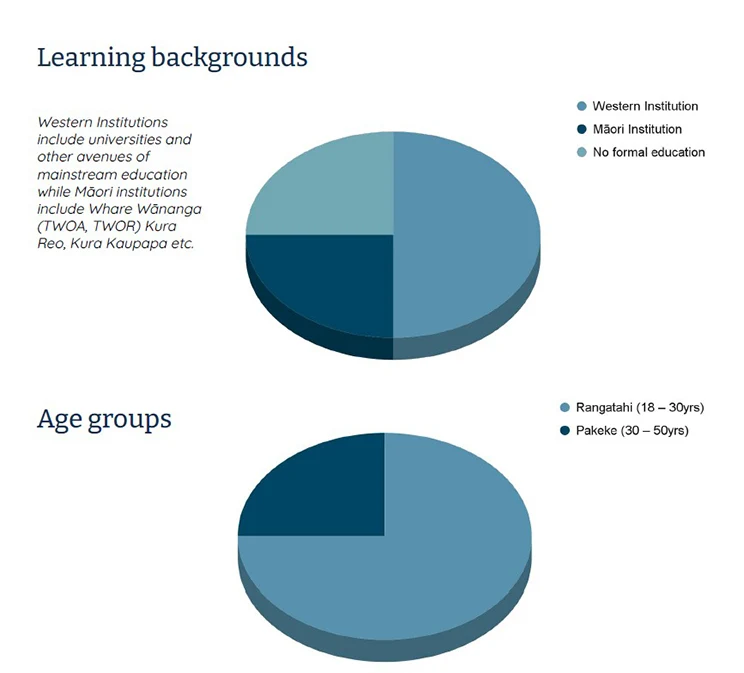
Pie charts showing information about the workshop participants. Supplied by IDIA, Indigenous Design and Innovation Aotearoa.
Workshop approach
We organised a workshop to explore some of the less conclusive aspects of the interviews, to prioritise content for translation and to evaluate a concept for a responsive simultaneous dual-language experience and phased approach to delivery.
We invited a number of tāngata Māori with various familiarity and confidence speaking te reo Māori and had a wānanga about each of the aforementioned focal points.
This wānanga ran for ~120-min and in-person at our office. For those that were unable to attend, we provided a digital self-led alternative consisting of with two activities; one focused on prioritising content for translation, and another for evaluating the phased dual-language approach.
For those who were eager to participate but were unable to attend, we created individual digital self-led activities using Miro boards. There were two activities: one focused on prioritizing content for translation, and another on evaluating the phased dual-language approach.
Workshop focus
Understand where translation mahi can have the most impact over time.
Evaluate concept for a simultaneous dual-language experience and a potential phased approach to achieving this.
Desired output
A refined benchmark.
A priority order for translation efforts.
A clearer direction as to how to best present reo Māori content online.
Note-taking and thematic analysis
Audio recordings were created to support those note-taking, and digital notes were captured, collated and refined using Notability before being anonymised and brought into Miro for thematic analysis.
These will be deleted 3 weeks after the completion of this research engagement.
Observations and findings from our workshops
Prioritising content for translation — Card sort activities
We invited reo Māori speakers to think about which website content was most important to be translated in the immediate, short and long term.
They were presented with content from 3 websites; Archives New Zealand, Papers Past and Te Papa. From here we asked that they prioritise translation efforts based on what was most important, quite important and less important to them.
While each participant had ended up at one of the websites in some capacity at some point in time, it is worth noting that they are not heavy users of the websites and were largely looking at the online experiences with fresh eyes.
Going into this engagement we had anticipated that it might be challenging for participants to understand the depth of content available on each website and the relevance or potential relevance their might be for them. This turned out to be true as few of the participants understood the purpose of each website or the abundance of content available when accessing them.
This might suggest that there would be value in dedicating more focused time to better understand the impact of reo Māori content on individual websites.
Translation mahi for Archives New Zealand
Prioritised content for translation
Very important
Logo
Navigation
Titles/headings
Labels
Constitutional document pages
Services for iwi
National war art collection
About page
Plan your visit
What we have
Collections
Events
Exhibitions
Quite important
News/updates
Blog articles
Resource guides
Search
Filters/sort options
Links and buttons
Less important
Visit a Reading Room
Managing information
Help with your Research
Contact page
Translation mahi for Papers Past
Prioritised content for translation
Very important
Logo
Navigation
Titles/headings
Labels
Home page
Pages about Māori taonga e.g.Ngā tānga reo Māori page
About page
Quite important
Website alerts
Filters/sort options
Links and buttons
Help popups
Less important
Help page
Contact page
Terms and conditions
Translation mahi for Te Papa Tongarewa
Prioritised content for translation
Very important
Titles/headings
Navigation
Labels
Home page
About us
Repatriation pages
Educator resources
Our strategy
Event information
Kids and family at home activity
Links and buttons
Online collections
Exhibition information
Howtocarefortaonga
Press releases
Statutory documents
Quite important
Object labels(item details),object descriptions (Overview)
Exhibition information
Web hub master pages
Web hub content pages
Less important
Getting here
Search tips
General findings for card sort activity and discussion
Translation of headings, labels and navigation improves scannability and wayfinding
In terms of accessibility, a dual-language approach to headings, labels, and navigation is preferred. This not only suggested the organisation's value of the reo, but also improved scannability for reo Māori speakers and enhanced their ability to navigate the website.
Dual-language logos are appreciated and often expected
Dual-language logos are appreciated when expressing value of te reo Māori and a commitment to Te Tiriti. Although it was noted that a change in the organisation’s name and/or logo should only come about after organisational change.
‘From what I know and have seen, the National Library holds a lot of documents, pikitia and
pukapuka etc that are really insightful in deeper research about Māori figures and events in te ao Māori, so I think it would be nice to see a bit of a rebrand in their logo to reflect their housing of knowledge.’
The integration of te reo and ahurea Māori in public spaces helps to ensure the success of Maihi Karauna for Tauiwi and Māori.
One of the goals of Maihi Karauna is to ensure that by 2040, 1 million New Zealanders value te reo as a key part of our nation. Participants expressed that a reo e rua approach enables content to be fully accessible and is perhaps less intimidating than a rumaki (full immersion) experience — not only for Tauiwi, but also for tangata Māori who are yet to connect with te reo.
Legislative change was highlighted as part of the long-term vision, however, at this point, we’re focussing on the things we can do to begin to better support hapori Māori.
‘Te Papa is so important as an entity to be a platform for the education of tauiwi to learn
and understand Māori culture, even if it's only slightly. I think only having content/kaupapa
available in te reo Māori could actually work against these efforts.’
‘Having that bilingual presentation e rua e rua ki reo Māori me reo Pākehā to me conveys at
least an effort to acknowledge all the ‘baggage’ that comes with rectifying [past] wrongs and inequities.’
Right now it’s key to focus translation efforts on kaupapa Māori.
This includes writings about Māori history and historical events, taonga Māori, ahurea Māori, and te ao Māori. There is also an opportunity to provide a Māori perspective on Aotearoa history that may currently be told from a predominantly Pākehā perspective.
All future content should be translated.
While we focused on existing website content, there was an expectation that anything that was deemed relevant to tāngata Māori and te ao Māori.
Educator resources should be available in te reo Māori to support teachers.
Participants highlighted the importance of educators and the essential role they play in re-centering histories and narratives regarding te ao Māori. It was deemed vital that to provide access to high-quality resources to support teachers to achieve this and that these resources should be offered in te reo Māori as there is a clear opportunity to whakamana the language in schools across the country.
‘I don't want to say that providing information of any sort in te reo Māori is the only way to
encourage Māori engagement and recognition of the services provided by Archives NZ (and other entities), but having that bilingual presentation e rua e rua ki reo Māori me reo Pākehā to me conveys at least an effort to acknowledge all the 'baggage' that comes with rectifying [past] wrongs and inequities.’
Evaluating a dual-language experience
Design evaluation activity
After completion of the interview phase, it become abundantly clear that there was a strong desire to see both te reo Māori and English content presented side-by-side.
This approach provided a natural opportunity to develop one’s reo, and reduced the need to toggle between languages and/or navigate to Te Aka to understand the meaning of unfamiliar kupu Māori. It is also in line with the bilingual signage approach from Te Puni Kōkiri.
Taking cues from the interview findings, IDIA and the project team ran an ideation session to explore what a responsive dual-language experience might look like and how we might take a phased approach to transition from a predominantly English experience to a dual-language experience to a rumaki reo one.
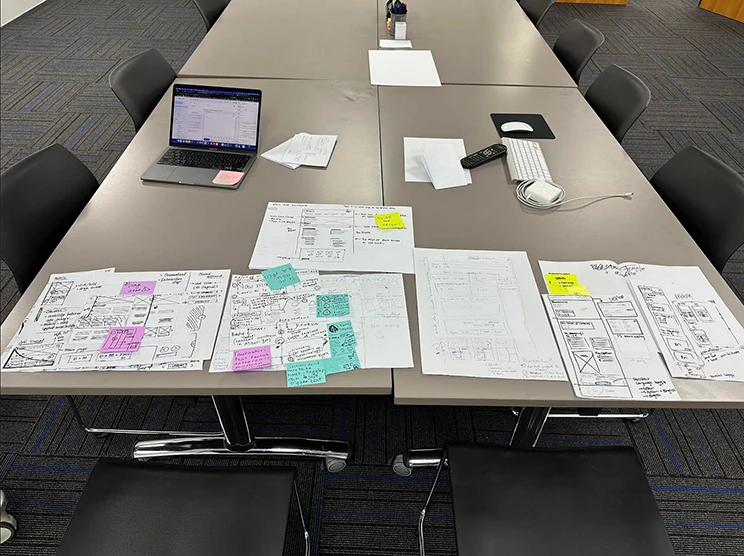
Notes from a workshop.
Taking a phased approach
Exploring how we can best present reo Māori content
Current state — Largely English experiences with ver little re Māori content available or whakaaro Māori included as part of the digital experience. (We are largely here at this point)
Phase one — Introduce dual-language titles, headings, and navigation.
Phase two — Build upon phase one and introduce more prominent reo Māori content displayed alongside English with the option to toggle between English and Māori too.
Phase three — A fully immersive reo Māori experience.
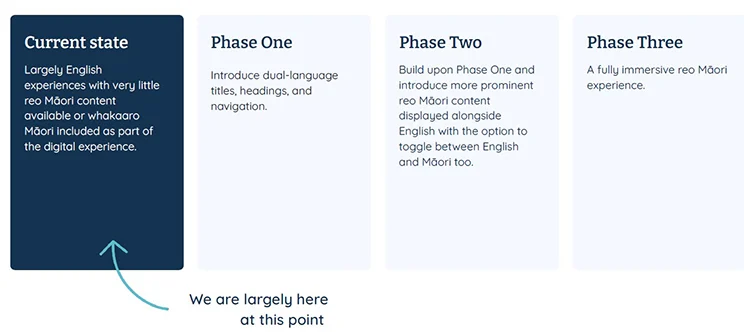
Infographic of phased approach. Supplied by IDIA, Indigenous Design and Innovation Aotearoa.
Concepts for evaluation
Phase one: Dual-language titles, headings, and navigation
This phase is still a largely English language experience however we begin to introduce dual-language headings, labels, breadcrumbs etc to improve scannability and navigation for reo Māori speakers.
Reo Māori is displayed first (top to bottom, left to right) and is visually distinguishable from English to communicate its value and to invite readers to engage with reo Māori.
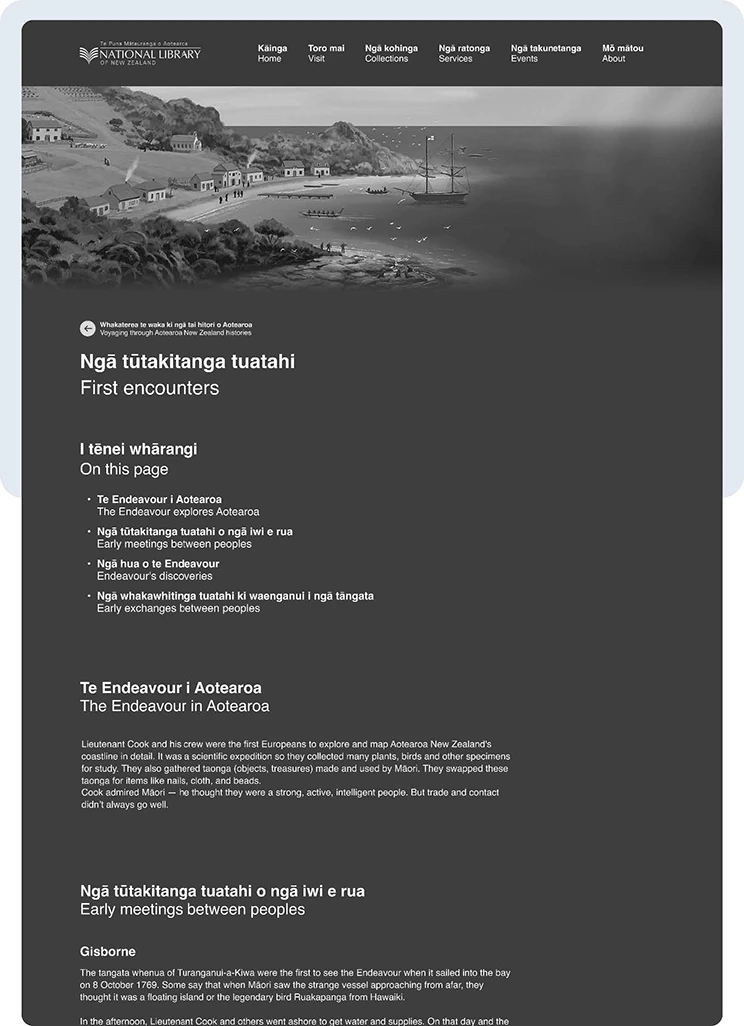
Example of phase one shows dual-language titles, headings, and navigation.
Phase two: Reo e rua experience
Phase two builds on the efforts made during phase one and takes things one step further displaying reo Māori article content alongside English.
By displaying both translations in close proximity, readers can stay engaged with the content and easily find translations if necessary. If they encounter unfamiliar kupu Māori, they can quickly scan the English content without having to resort to using a dictionary or search for the translation.
Phase two also introduces a toggle enabling users to toggle between dual display of te reo and English, Māori and English. Dual language display would be the initial default, however the user’s preference would be recognised, stored and respected when they return to the website.

Example of phase two shows te reo Māori article content alongside English and a toggle to allow users to choose language display.
Phase three: Rumaki reo experience
A togglable immersive reo Māori experience where all content is available in te reo Māori.
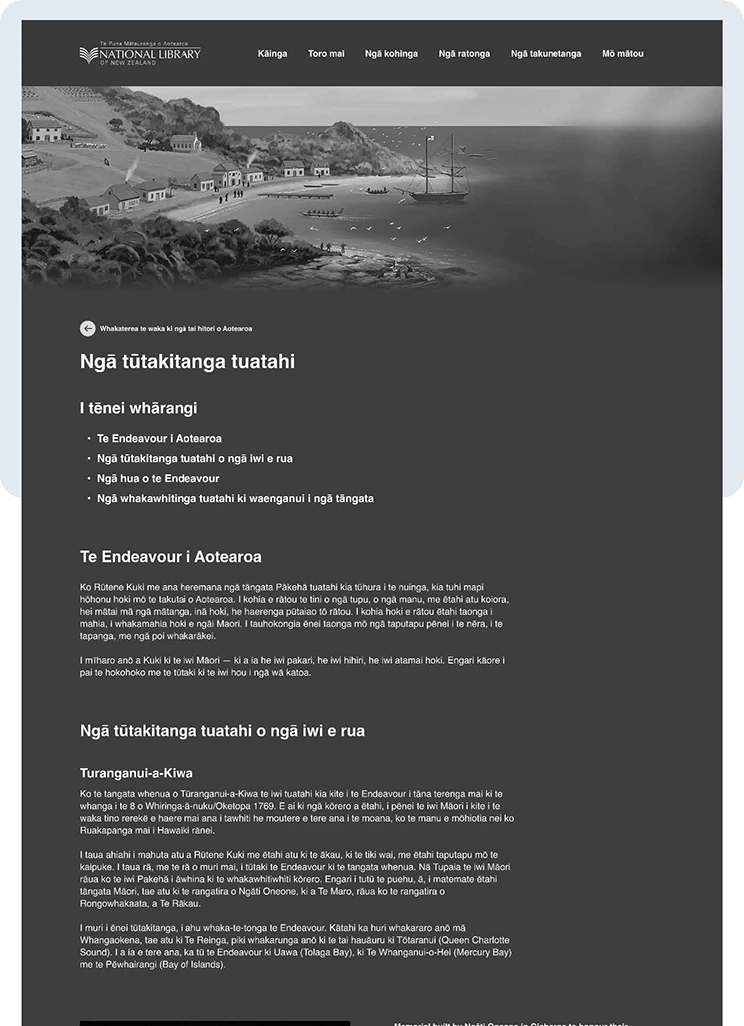
Example of phase three shows a web page in te reo Māori with an option to toggle to an English page.
Evaluating a reo e rua experience — General findings
There was unanimous support and enthusiasm for the simultaneous reo e rua design.
As recognised during the interviews, the learning opportunity that use of reo e rua provides remains a strong reason for this preference. The way that te reo Māori is visually distinguished and displayed first (top to bottom, left to right) successfully communicated the deliberate prioritisation and appreciation of te reo Māori.
Participants appreciated taking a dual-language approach to navigation, headings, labels etc as part of phase one (card sort activity) and responded positively when te reo Māori was made prominent and consistently presented.
Participants also appreciated the dual-language approach to body content as part of phase two and understood that the need for the phased approach came about due to resources/investment rather than the number of kaiwhakaMāori available to do the work.
A reo e rua approach offers an invitation to non-Māori to draw nearer to te ao Māori.
Deliberate elevation and increased exposure to te reo Māori was seen to as a welcoming invitation to tāngata Tiriti and tauiwi whānau who may be navigating or curious about navigating through te ao Māori by engaging with te reo.
People understood the phased approach and the benefit of each phase while also recognising the effort involved.
‘Slowly increasing te reo Māori on a website is great! It's a gradual change that takes into consideration frequent users of the website but also those operating on the back end. A website change is huge, let alone adding a new language so this considers everyone interacting with the website and allows for everyone to get familiar with the new norms of the website first.’
Despite understanding the phased approach, there were many who would prefer a leap from phase one to phase two sooner rather than later.
Some suggested a dual-language approach might reduce a more adverse response from non-Māori and might maintain inclusivity.
‘I think it's a nice way to do it if there is concern that people will react too strongly to going straight to phase three (rumaki reo experience).’
It will be important to prototype and test a mobile experience more extensively.
While the experience for larger devices was very well-received, there was slight uncertainty about the experience for smaller devices.
They liked the idea of being able to jump between reo Māori and English content blocks, but were unsure how this experience might feel if they were really in a research mindset, which is a fair and astute thing to recognise.
There’s room to better communicate the value and the function of the language toggle.
They also suggested there could be value in heightening people's awareness of the language toggle from the get-go. It was suggested that an overlay, a quick walk-through or a spotlight approach could be a start for first-time visitors of the websites.
It was also noted that this could be a persistent element which was ever present as the user engaged with the website.
Moving forward — Recommended next steps
Thinking about what could be further explored to enhance the experience and who could be brought along on this journey in the future.
Prototype, test and evaluate ideal online reo Māori experiences with a broader segment of our wider community to ensure an accessible and more inclusive digital experience for those accessing your digital services.
While we’ve already evaluated some initial concepts with speakers of te re Māori, and these were well-received, there were aspects of the responsive experience for smaller devices that could benefit from additional exploration and enhancement. There may be more to be done to feel confident and reassured to move forward into a production environment where there may be cross-website or cross-organisation impact.
From this point, we would recommend:
speak directly with whānau hauā/tāngata whaikaha to understand how appealing the proposed experience is, create new concepts if required, and learn how to enhance the experience to be even more accessible to a wider audience
digitise concepts with a focus on accessibility and responsive design and evaluate the prototypes with Pākehā, Tauiwi, and Tāngata Tiriti.
25% of our general population identifies as being disabled, within this, tāngata whaikaha (Māori from the disability community) make up 26% of Māori in Aotearoa.
Any public communications made by Government need to meet digital accessibility guidelines, and within the context of the use of te reo Māori online, it is essential that we engage and collaborate with tāngata whaikaha to ensure success.
‘All government entities have obligations to Te Tiriti and to the recognition of our language as a taonga. What can be done in that space to whakamana?’
Wenerei 26 Mei 2023